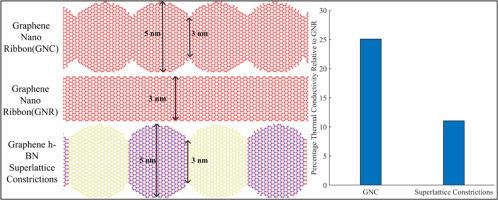Reduced thermal conductivity of constricted graphene nanoribbons for thermoelectric applications
IF 3.1
Q2 MATERIALS SCIENCE, MULTIDISCIPLINARY
引用次数: 0
Abstract
Graphene nanoribbons (GNRs) hold promise as thermoelectric (TE) materials due to their advantageous electronic properties compared to conventional candidates. However, a key challenge to enhancing the TE performance of GNRs lies in reducing the thermal conductivity while maintaining the electronic transport properties. To address this challenge - this study proposes a GNR-based structure featuring nanoscale constrictions named graphene nano constrictions (GNCs). This work systematically analyzes the thermal transport properties of these GNCs and compares them to conventional GNRs. Non-Equilibrium Molecular Dynamics (NEMD) simulations were employed to evaluate the lattice thermal conductivity of the material, and a marked reduction of thermal conductivity exceeding 74 % was observed in the proposed structures. Furthermore, it is revealed that the thermal conductivity of these structures can be further tailored by manipulating their physical geometry, focusing on the length and the constriction dimensions. Additionally, superlattice counterparts of the GNCs composed of graphene and h-BN are explored in this study. Subsequently, an 88 % reduction of lattice thermal conductivity is observed in the superlattice counterparts of GNCs compared to GNRs. Overall, this study demonstrates the effectiveness of nanoscale constrictions in manipulating the thermal conductivity of GNR-based structures, creating a path for optimizing their TE performance and potential device applications.

降低热电应用中受限石墨烯纳米带的热导率
石墨烯纳米带(GNR)具有优于传统候选材料的电子特性,有望成为热电(TE)材料。然而,要提高 GNR 的热电性能,关键的挑战在于如何在保持电子传输特性的同时降低热导率。为了应对这一挑战,本研究提出了一种基于 GNR 的结构,该结构具有纳米级收缩,被命名为石墨烯纳米收缩(GNCs)。这项工作系统地分析了这些 GNC 的热传输特性,并将其与传统的 GNR 进行了比较。研究人员采用非平衡分子动力学(NEMD)模拟来评估材料的晶格热导率,结果发现拟议结构的热导率明显降低,降幅超过 74%。此外,研究还发现,这些结构的热导率可以通过操纵其物理几何形状(主要是长度和收缩尺寸)来进一步调整。此外,本研究还探讨了由石墨烯和 h-BN 组成的 GNC 的超晶格对应物。结果发现,与 GNRs 相比,GNCs 的超晶格对应物的晶格热导率降低了 88%。总之,本研究证明了纳米级约束在操纵基于 GNR 结构的热导率方面的有效性,为优化其 TE 性能和潜在的器件应用开辟了一条道路。
本文章由计算机程序翻译,如有差异,请以英文原文为准。
求助全文
约1分钟内获得全文
求助全文
来源期刊

Carbon Trends
Materials Science-Materials Science (miscellaneous)
CiteScore
4.60
自引率
0.00%
发文量
88
审稿时长
77 days
 求助内容:
求助内容: 应助结果提醒方式:
应助结果提醒方式:


